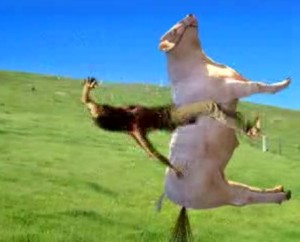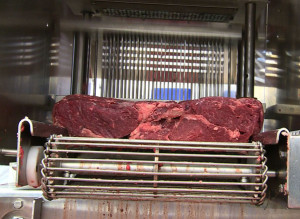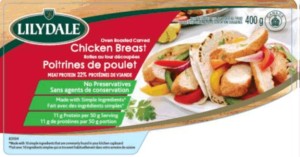Fifteen years old, written for me by Rena Orr while I was a prof at Guelph, and I’m still citing it.
 The gastrointestinal tract of animals and humans is an ideal habitat for the growth of mostly harmless bacteria. Escherichia coli (E. coli) is a normal inhabitant of the human gastrointestinal tract. The 0157:H7 strain of E. coli, however, is responsible for the illness known as hamburger disease. As few as 10 viable E. coli O157:H7 can cause infection. Victims may experience severe cramping and abdominal pain, watery or bloody diarrhea, vomiting or low-grade fever for an average of eight days. It can also cause kidney failure and death, primarily in children and immune compromised adults.
The gastrointestinal tract of animals and humans is an ideal habitat for the growth of mostly harmless bacteria. Escherichia coli (E. coli) is a normal inhabitant of the human gastrointestinal tract. The 0157:H7 strain of E. coli, however, is responsible for the illness known as hamburger disease. As few as 10 viable E. coli O157:H7 can cause infection. Victims may experience severe cramping and abdominal pain, watery or bloody diarrhea, vomiting or low-grade fever for an average of eight days. It can also cause kidney failure and death, primarily in children and immune compromised adults.
A small percentage of cattle are carriers of E. coli O157:H7. The prevalence of Shiga toxin‑producing Escherichia coli (STEC) in beef slaughter steers and heifers on P.E.I. was reported to be 4% (2000, Douglas Schurman). When meat is contaminated with cattle feces at slaughter, this strain of E. coli can enter the food chain. With the increasing use of hazard analysis and critical control point ( HACCP) plans, dietary management during the pre-slaughter period of beef production may play a role in reducing the incidence of E. coli O157:H7‑positive ruminants. Reducing the levels of E. coli O157:H7 organisms that enter slaughter plants would require two interrelated strategies: (i) reducing the number of cattle shedding E. coli O157:H7 and (ii) reducing the magnitude of shedding (CFU/gram) by those animals infected with the organism (1998, Cray Jr.).
 Since September 1998, there has been conflicting information on the effect of diet on E. coli shedding from cattle. The conflict arises in part from the effect of diet on the ability of E. coli to develop acid resistance. The induction of acid resistance could increase the risk of human food‑borne illness. Normally, stomach acid is an effective barrier to infection by food‑borne pathogens because the organisms die in an acid environment. Acid resistant bacteria are able to survive this defence mechanism, reproduce, and produce the toxins that cause disease.
Since September 1998, there has been conflicting information on the effect of diet on E. coli shedding from cattle. The conflict arises in part from the effect of diet on the ability of E. coli to develop acid resistance. The induction of acid resistance could increase the risk of human food‑borne illness. Normally, stomach acid is an effective barrier to infection by food‑borne pathogens because the organisms die in an acid environment. Acid resistant bacteria are able to survive this defence mechanism, reproduce, and produce the toxins that cause disease.
Diez‑Gonzalez et. al demonstrated that feeding a high‑grain diet to cattle results in an acidic environment in the colon. Because the animals incompletely digested the starch in grains, some starch was able to reach the colon where it fermented, producing fermentation acids. The researchers believe an acidic environment selects for or induces acid resistance among the Escherichia coli population.
On a diet of hay, there is no residual starch to be fermented in the colon. Thus, the acid level remains low and the E. coli remain acid‑sensitive. Acid‑sensitive E. coli are easily destroyed in the human stomach. Diez‑Gonzalez et al. concluded that if cattle were given hay for a brief period (five days) immediately before slaughter, the risk of food‑borne E. coli infection would be significantly reduced because the acidity in the colon is greatly reduced. “Our studies indicate that cattle could be given hay for a brief period immediately before slaughter to significantly reduce the risk of food‑borne E. coli infection.” This finding was supported by studies on fecal shedding of E. coli 0157H7. Van Donkersgoed et al. concluded that feces and rumen content are sources of E. coli and Victor Gannon et al. showed that there were significantly fewer E. coli isolated from steers changed to an alfalfa hay diet for three weeks than for steers that stayed on silage/grain. The effect of dietary stress such as fasting has also been demonstrated to increase fecal shedding of E. coli O157:H7. The Science article received mainstream media attention, and was covered by the Associated Press and The New York Times, as well as scientific releases and reports. In the Irish Times, it was cited as the basis for concluding that because Irish cattle are fed a grass‑based diet rather than grain, Ireland has a low incidence of E. coli 0157:H7.
Hancock et al. contend that this conclusion is unsupported or contradicted by several lines of evidence. The E. coli that contaminate beef typically originate from the hide, the hooves, or the equipment used in slaughter and processing rather than directly from the colon, and likely replicate in environments unlike the colon. Therefore, the induced acid resistance of E. coli contaminating beef is likely to be unrelated to the pH of its ancestral colonic environment. The E. coli O157:H7 bacterium uses several mechanisms to survive acid environments, some of which are innate and are not influenced by environment . Although acid resistance is likely a factor in an infective dose, induced acid resistance has not been shown to be a factor in E. coli O157:H7 infectivity by experimental (dose‑inoculation) or observational (epidemiological) data . Therefore, acid resistance induced by exposure to weak acid may not influence the virulence of this pathogen.
 Published data on E. coli O157:H7 tends to contradict or does not support the effects of the dietary change proposed by Diez‑Gonzalez et al. In a recent study on three different grain diets (85% cracked corn, 15% whole cottonseed and 70% barley, or 85% barley), the fecal pH of the animals fed the corn diet was significantly lower (P < 0.05) than the fecal pH of the animals fed the cottonseed and barley and barley diets, likely resulting in a less suitable environment for E. coli O157:H7 in the hindgut of the corn fed animals (2000, Buchko et al). In the Journal of Food Protection, researchers concluded that changing from grain to a high roughage diet did not produce a change in the E. coli concentration that was large enough to deliver a drastic improvement in beef carcass hygiene. Sheep experiencing an abrupt diet change have higher concentrations and increased shedding of fecal E. coli O157:H7 for longer periods than sheep fed a consistent high‑grain diet. Another study compared the duration of shedding E. coli O157:H7 isolates by hay‑fed and grain‑fed steers experimentally inoculated with E. coli O157:H7 as well as the acid resistance of the bacteria. The hay‑fed animals shed E. coli O157:H7 longer than the grain‑fed animals, and irrespective of diet, these bacteria were equally acid resistant.
Published data on E. coli O157:H7 tends to contradict or does not support the effects of the dietary change proposed by Diez‑Gonzalez et al. In a recent study on three different grain diets (85% cracked corn, 15% whole cottonseed and 70% barley, or 85% barley), the fecal pH of the animals fed the corn diet was significantly lower (P < 0.05) than the fecal pH of the animals fed the cottonseed and barley and barley diets, likely resulting in a less suitable environment for E. coli O157:H7 in the hindgut of the corn fed animals (2000, Buchko et al). In the Journal of Food Protection, researchers concluded that changing from grain to a high roughage diet did not produce a change in the E. coli concentration that was large enough to deliver a drastic improvement in beef carcass hygiene. Sheep experiencing an abrupt diet change have higher concentrations and increased shedding of fecal E. coli O157:H7 for longer periods than sheep fed a consistent high‑grain diet. Another study compared the duration of shedding E. coli O157:H7 isolates by hay‑fed and grain‑fed steers experimentally inoculated with E. coli O157:H7 as well as the acid resistance of the bacteria. The hay‑fed animals shed E. coli O157:H7 longer than the grain‑fed animals, and irrespective of diet, these bacteria were equally acid resistant.
These results suggest that the proposed dietary change would actually increase contamination with E. coli O157:H7. Also, the 1,000‑fold reductions in total fecal E. coli demonstrated by Diez‑Gonzales et al. are far greater than those recorded in cattle experiencing similar ration changes. Finally, extensive surveys show that grain‑fed feedlot cattle have no higher E. coli O157:H7 infection prevalence than similarly aged dairy cattle fed forage (hay) diets. Abrupt feed change immediately before slaughter could have unexpected deleterious effects. The proposed diet change has the potential to increase the risk of bovine salmonella infections, a potential source of food poisoning. The dietary change results in sharply reduced volatile fatty acid
concentrations in the large intestine as well as changes in the bacteria, allowing for colonization of Salmonella.
Several people interviewed in the media, including U.S. Agriculture Secretary Dan Glickman, Dr. Gary Weber of the National Cattlemen’s Beef Association and Dr. Robert Buchanan, a microbiologist at the Food and Drug Administration, and the authors, including Diez-Gonzalez, of a review article of recent research pointed out the need for further study to confirm that cattle feeding management practices may be manipulated to decrease the risk of foodborne illness from E. coli . Glickman said in a statement that the findings, if confirmed by additional research, “have the potential to greatly assist efforts to fight foodborne illness” and may lead the U.S. Department of Agriculture to recommend changes in the way cattle are fed. Peter Doris of the Ontario Cattlemen’s Association recommended a “cautious approach” on this issue. “Subjecting cattle to a special diet before slaughter is a problem in itself since most market‑ready cattle are sorted from pens in feedlots no more than 12 hours before they board the truck to the packing plant . Before we get to that point, we need to clarify if the research findings are valid”.
References
Buchko, S. J., R. A. Holley, S. J. Buchko, W. O. Olson, V. P. J. Gannon, and D. M. Veira. The Effect of Different Grain Diets on Fecal Shedding of Escherichia Coli O157:H7 by Steers Journal of Food Protection: October 2000 Vol. 63, No. 11, pp. 14671474
Brody, Jane E. The New York Times: September 11, 1998.
Cray Jr., William C., Thomas A. Casey, Brad T. Bosworth, and Mark A. Rasmussen. Effect of Dietary Stress on Fecal Shedding of Escherichia coli O157:H7 in Calves. Applied Environmental Microbiology: May 1998, p. 1975‑1979, Vol. 64, No. 5
Diez‑Gonzalez, Francisco, Todd R. Callaway, Menas G. Kizoulis, James B. Russell.
Grain Feeding and the Dissemination of Acid‑Resistance Escherichia coli from Cattle.
Science: Sept 11, 1998. Volume 281, Number 5383, pages 1666‑1668.
Douglas Schurman R., Harry Hariharan and Susan Heaney. Prevalence And Characteristics of Shiga Toxin‑producing Escherichia Coli in Beef Cattle Slaughtered on Prince Edward Island
Journal of Food Protection: November 2000. Vol. 63, No. 11, pp. 15831586.
Farm and Country: Scientists Debate Hay vs Corn. October 19, 1998
Gannon, Victor, Thomas Graham, Walter Olson, Roger Johnson: Fecal Shedding of
Escherichia coli O157:H7 during the Beef Cattle Production Cycle. Health Canada and
Agriculture and Agri‑Food Canada, Lethbridge Alberta and Health Canada, Guelph,
Ontario http://sun1.bham.ac.uk/bcm4ght6/res.html
Hancock, Dale D., Thomas E. Besser (College of Veterinary Medicine, Washington State University, Pullman, WA 99164, USA), Colin Gill (Agriculture and Agri‑Food Canada Research Center, Lacombe, Alberta, Canada T4L1W1), Carolyn Hovde Bochach (Department of Microbiology, Molecular Biology, and Biochemistry, University of Idaho, Moscow, ID 83844, USA): Cattle, Hay, and E. coli. Science, April 2, 1999 Volume 284, Number 5411, Page 49.
Hovde, Carolyn, et al. Applied and Environmental Microbiology: 65: 3233‑3235. 1999
Jordan, David, Scott McEwen. Effect of Duration of Fasting and a Short‑Term High Roughage Ration on the Concentration of Escherichia coli Biotype 1 in Cattle Feces. Journal of Food Protection 1998. Volume 61, No. 5, pages 531‑534.
Kudva, Indira T., Carl W. Hunt, Christopher J Williams, Ursula M. Nance, Carolyn J.
Hovde: Dietary Influences on the Shedding of Escherichia coli 0157:H7 by Ruminants.
Department of Microbiology, Molecular Biology and Biochemistry, Department of
Animal and Veterinary Sciences and Division of Statistics, University of Idaho, Moscow,
Idaho http://sun1.bham..ac.uk/bcm4ght6/res.html
O’Sullivan, Kevin. Irish Times: September 23, 1998.
Russell JB, F Diez‑Gonzalez, GN Jarvis. Invited review: effects of diet shifts on Escherichia coli in cattle. Journal of Dairy Science: 2000 Apr;83(4):863‑73
Tkalcic, Suzana, Barry G. Harmon, Cathy A. Brown, E. Mueller, A. Parks, T. Zhao, M.P.
Doyle: Effects of the Rumen Microenvironment on the Growth and Fecal Shedding of E
coli 0157:H7. The Department of Pathology and Department of Food Science and
Technology, University of Georgia. http://sun1.bham.ac.uk/bcm4ght6/res.html
Van Donkersgoed, Joyce, (Alberta Agriculture, Food and Rural Development, 11 Bruns
Road, Lacombe, Alberta, T4L 1P1), Tom Graham, Vic Gannon (Animal Diseases
Research Institute, Health Canada., Lethbridge Alberta). The Prevalence of Verotoxins,
- coli O157:H7 and Salmonella in the Feces and Rumen of Cattle at Processing.
 As the name suggests, mechanically tenderized beef has been put through a machine that breaks up the muscle fiber and tough connective tissue with blades or needles. This promotional video for the Jaccard Model H Commercial Meat Tenderizer shows just what that looks like (below).
As the name suggests, mechanically tenderized beef has been put through a machine that breaks up the muscle fiber and tough connective tissue with blades or needles. This promotional video for the Jaccard Model H Commercial Meat Tenderizer shows just what that looks like (below).











